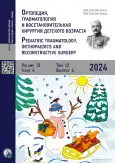Results of foot assessment in healthy preschool children: visual assessment, FPI-6, dorsiflexion: a population study
- Authors: Dimitrieva A.Y.1
-
Affiliations:
- H. Turner National Medical Research Center for Сhildren’s Orthopedics and Trauma Surgery
- Issue: Vol 12, No 4 (2024)
- Pages: 437-444
- Section: Clinical studies
- URL: https://bakhtiniada.ru/turner/article/view/282513
- DOI: https://doi.org/10.17816/PTORS641748
- ID: 282513
Cite item
Abstract
BACKGROUND: The reason for conducting this study was the lack of Russian literature on the relationship between visual foot assessment using the Foot Posture Index (FPI)-6 and foot dorsiflexion in preschool children.
AIM: The aim was to evaluate the relationship between visual foot assessment, FPI-6 and dorsiflexion in healthy preschool children.
MATERIALS AND METHODS: The study included 81 children aged 5–7 years (162 feet). All children were examined using visual foot assessment, FPI-6, assessment of passive dorsiflexion, Beighton hypermobility score, and anthropometric measurements (height/weight). Dorsiflexion was assessed with posterior segment stabilization and the knee joint in flexion and extension. The Kolmogorov–Smirnov test was used to assess the normality of the data distribution, followed by the use of parametric and non-parametric statistical tests. The analysis of variance (ANOVA) was used to compare the means of three groups. The Pearson’s test was used to assess correlations.
RESULTS: Flat feet was diagnosed in 41.0% of children. There were 2 times more boys than girls in the group with flat feet and 1.5 times more girls in the group without flat feet. The FPI-6 scores of the same feet were at least 8 in children with flat feet and 0 to 4 in children without flat feet. Moderate to medium correlations were found between the clinical diagnosis of flat feet and FPI-6 scores. In 95% of the children aged 5–7 years, dorsiflexion with the knee joint in extension was 11.4°–34.2°. Mean dorsiflexion difference between flexed and extended knees was 24.1° ± 9.5°. ANOVA showed no significant difference in dorsiflexion between children with and without flat feet.
CONCLUSIONS: The mean dorsiflexion in preschool children was 22.8° ± 5.7°. No reliable difference in dorsiflexion between children with and without flat feet was demonstrated. Gastrocnemius muscle retraction was evaluated quantitatively.
Full Text
##article.viewOnOriginalSite##About the authors
Alyona Yu. Dimitrieva
H. Turner National Medical Research Center for Сhildren’s Orthopedics and Trauma Surgery
Author for correspondence.
Email: aloyna17@mail.ru
ORCID iD: 0000-0002-3610-7788
SPIN-code: 7112-8638
MD, PhD, Cand. Sci. (Medicine)
Russian Federation, Saint PetersburgReferences
- Didia BC, Omu ET, Obuoforibo AA. The use of footprint contact index II for classification of flat feet in a Nigerian population. Foot Ankle. 2016;7(5):285–289. doi: 10.1177/107110078700700504.
- Echarri JJ, Forriol F. The development in footprint morphology in 1851 Congolese children from urban and rural areas, and the relationship between this and wearing shoes. J PediatrOrthop B. 2003;12(2):141–146. doi: 10.1097/00009957-200303000-00012.
- Armasov AR. Diagnostic value of the method of visual assessment of feet in the diagnosis of flat feet in adolescents. Genius of Orthopedics. 2010;(3):101–104. EDN: MTYNSN
- Gross NA, editor. Physical rehabilitation of children with musculoskeletal disorders. Moscow: Soviet Sport; 2000. 222 p. EDN: YVCLNG
- Dimitrieva AYu, Kenis VM, Sapogovskiy AV. Flatfoot or not: subjective perception of the height of the feet arch among orthopedists. Pediatric Traumatology, Orthopaedics and Reconstructive Surgery. 2020;8(2):179–184. EDN: KKQRVL doi: 10.17816/PTORS21192
- Cowan DN, Robinson JR, Jones BH, et al. Consistency of visual assessments of arch height among clinicians. Foot Ankle Int. 1994;15(4):213–217. doi: 10.1177/107110079401500411.
- Dimitrieva AYu, Kenis VM, Klychkova IYu, et al. Results of the first Russian Delphi survey on the diagnosis and treatment of flatfoot in children. Pediatric Traumatology, Orthopaedics and Reconstructive Surgery. 2023;11(1):49–66. doi: 10.17816/PTORS112465
- Morrison SC, Ferrari J. Inter-rater reliability of the Foot Posture Index (FPI-6) in the assessment of the paediatric foot. J Foot Ankle Res. 2009;2:26. doi: 10.1186/1757-1146-2-26
- Sapogovskiy AV. Triceps surae shortening in children. Pediatric Traumatology, Orthopaedics and Reconstructive Surgery. 2024;12(1):19–27. EDN: JTQCLZ doi: 10.17816/PTORS625865
- Banwell HA, Paris ME, Mackintosh S, et al. Paediatric flexible flat foot: how are we measuring it and are we getting it right? A systematic review. J Foot Ankle Res. 2018;11(1). doi: 10.1186/s13047-018-0264-3
- Chuckpaiwong B, Nunley JA, Queen RM. Correlation between static foot type measurements and clinical assessments. Foot Ankle Int. 2009;30(3):205–212. doi: 10.3113/fai.2009.0205
- Tong JWK, Kong PW. Medial longitudinal arch development of children aged 7 to 9 years: longitudinal investigation. Phys Ther. 2016;96(8):1216–1224. doi: 10.2522/ptj.20150192.
- Mosca V. Principles and management of pediatric foot and ankle deformities and malformations. Wolters Kluwer Health; 2015. 285 p.
- Weir J, Chockalingam N. Ankle joint dorsiflexion: assessment of the true values. Int J Therapy Rehabilit. 2007;14(2):76–82. doi: 10.12968/ijtr.2007.14.2.23518
- DiGiovanni CW, Langer P. The role of isolated gastrocnemius and combined Achilles contractures in the flatfoot. Foot Ankle Clin. 2007;12(2):363–379. doi: 10.1016/j.fcl.2007.03.005
Supplementary files










